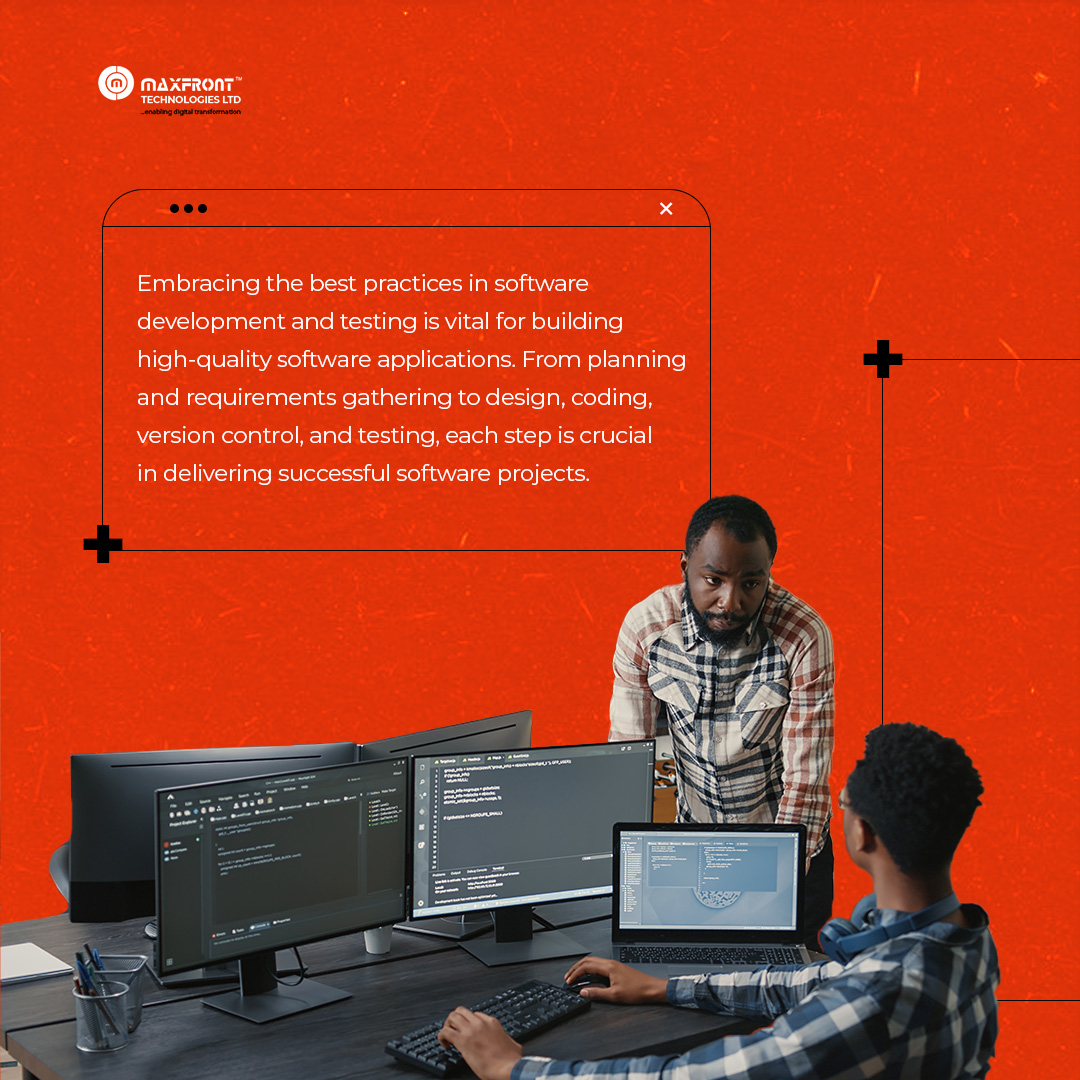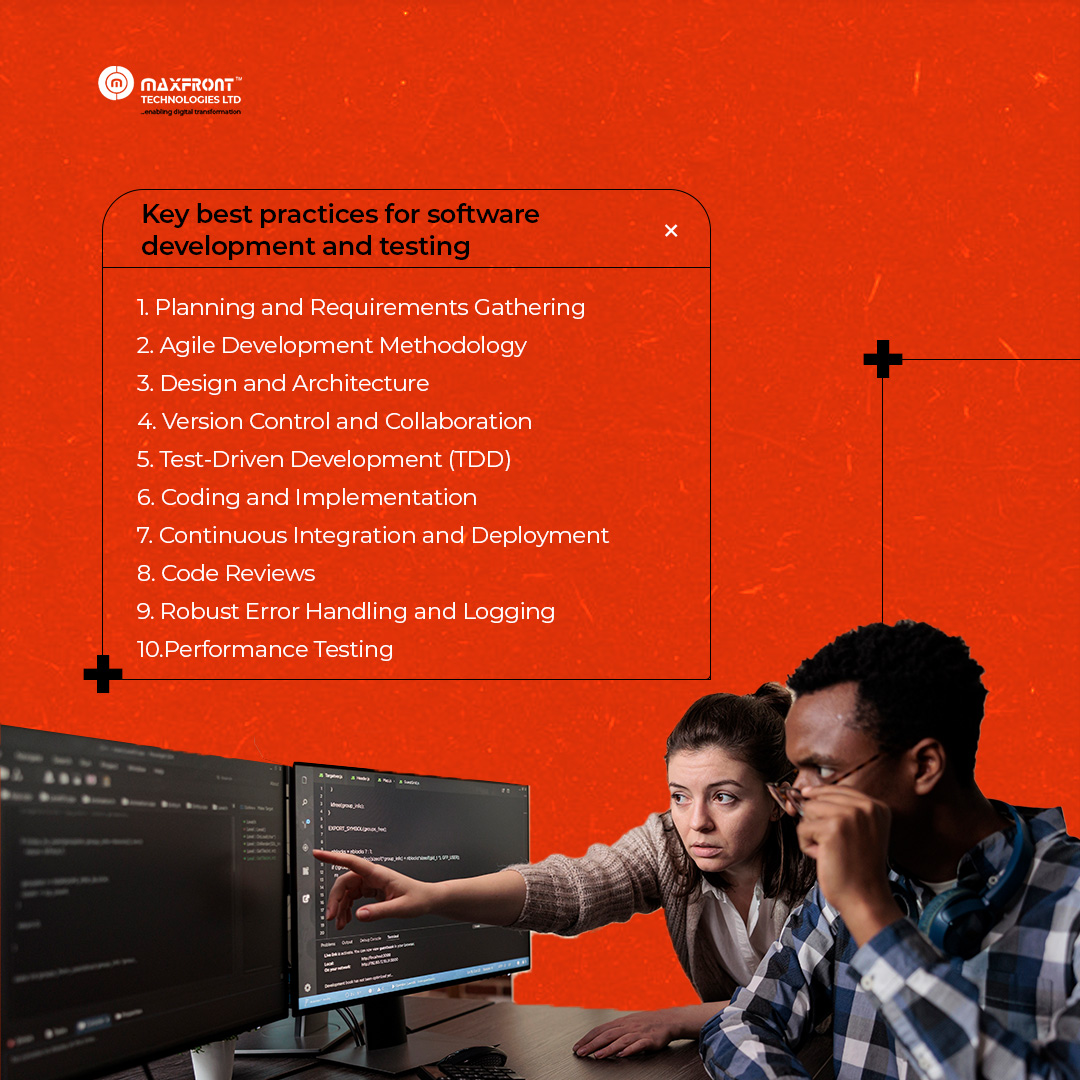
Software development and testing are essential processes for creating high-quality, reliable, and user-friendly software applications. By following best practices, developers and testers can ensure that the software meets the desired requirements, performs efficiently, and delivers a positive user experience. In this article, we will explore some of the key best practices for software development and testing, covering planning and requirements gathering, design and architecture, coding and implementation, version control and collaboration, and testing and quality assurance.

- Planning and Requirements Gathering:
- Clearly define the project goals, objectives, and requirements.
- Involve stakeholders in the planning process to ensure their needs are considered.
- Conduct thorough requirements gathering to capture all necessary functionality and specifications.
- Agile Development Methodology:
- Adopt an agile development methodology to enable iterative and incremental development.
- Break down the project into smaller, manageable tasks or user stories.
- Continuously prioritize and deliver value to the customer through regular iterations or sprints.
- Design and Architecture:
- Adopting a modular and scalable architecture is critical for building software that can adapt to changing requirements and accommodate future growth.
- Designing for reusability and maintainability allows components to be easily modified or extended.
- Applying design patterns and principles helps create robust and well-structured code.
- Version Control and Collaboration:
- Utilize a version control system to manage source code and track changes.
- Encourage collaboration and effective communication among team members.
- Ensure everyone is working on the latest code version and resolving conflicts promptly.
- Test-Driven Development (TDD):
- Follow the TDD approach by writing tests before writing the actual code.
- Write small, focused tests that verify specific functionalities or behaviours.
- Use tests as a means of documenting the expected behaviour of the code.
- Coding and Implementation:
- Following coding standards and style guidelines ensures consistency and readability across the codebase.
- Regular code reviews and refactoring help identify and address potential issues, improving code quality.
- Practicing pair programming promotes knowledge sharing and collaboration among team members.
- Continuous Integration and Deployment:
- Implement a continuous integration (CI) process to integrate code changes regularly.
- Automate the build, test, and deployment processes to ensure consistent and reliable software releases.
- Monitor the CI pipeline for failures or errors and address them promptly.
- Code Reviews:
- Conduct code reviews to identify potential issues, ensure adherence to coding standards, and improve code quality.
- Involve multiple team members in the review process to gain different perspectives.
- Provide constructive feedback and suggestions for improvement.
- Robust Error Handling and Logging:
- Implement robust error-handling mechanisms to handle exceptions and unexpected situations gracefully.
- Use appropriate logging techniques to capture relevant information for troubleshooting and debugging purposes.
- Monitor logs to identify and address potential issues proactively.
10. Performance Testing:
- Conduct performance testing to evaluate the software’s responsiveness, scalability, and stability under different loads.
- Identify and optimize any bottlenecks or performance issues.
- Ensure that the software meets the required performance criteria.
11. Version Control and Collaboration:
- Effective use of version control systems allows for proper source code management, tracking changes, and facilitating collaboration.
- Proper branching and merging strategies prevent conflicts and ensure a smooth development process.
- Encouraging open communication and cooperation among team members fosters a positive and productive work environment.
12. User Acceptance Testing (UAT):
- Involve end users or stakeholders in the UAT process to validate that the software meets their expectations.
- Collect feedback and address any identified issues or concerns.
- Ensure the software is intuitive, user-friendly, and meets the desired user experience.
13. Bug Tracking and Quality Assurance:
- Implementing different levels of testing, such as unit, integration, and system testing, helps identify and address bugs or issues early in the development process.
- Automation of test cases and regression testing enables efficient and reliable testing.
- Conducting thorough bug tracking and fixing ensures that software is stable and performs as expected.
- Documentation and Knowledge Sharing:
- Maintain proper documentation of the software architecture, design, and implementation details.
- Provide comprehensive and up-to-date documentation to aid in future maintenance and support.
- Encourage knowledge sharing among team members through code reviews, internal wikis, and regular team discussions.
Embracing the best practices in software development and testing is vital for building high-quality software applications. From planning and requirements gathering to design, coding, version control, and testing, each step is crucial in delivering successful software projects.
By incorporating these best practices, development teams can enhance productivity, improve software quality, and provide users with reliable and user-friendly software experiences. It is essential to continually evaluate and refine these practices to align with evolving industry standards and technologies. By embracing a culture of continuous improvement and learning, software development efforts can thrive and achieve long-term success.
Stay current with industry standards, embrace emerging technologies, and foster a culture of innovation and growth. By doing so, you can ensure that your software development and testing processes consistently deliver exceptional results.